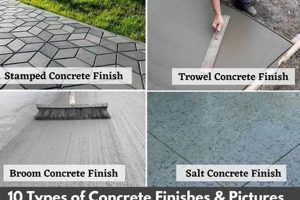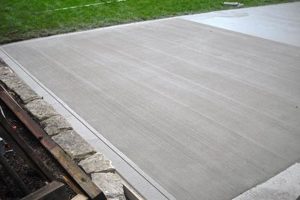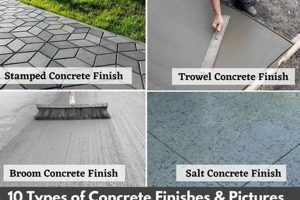Surface treatments applied to concrete on external structures offer diverse aesthetic and protective capabilities. These treatments range from simple textured surfaces achieved during the pouring process to complex applied coatings and sealants. For instance, exposed aggregate finishes showcase the natural beauty of the stone components within the concrete mix, while smooth, troweled surfaces provide a modern, minimalist appearance.
The appropriate selection of a surface treatment is critical for enhancing durability, minimizing maintenance, and improving the overall appearance of a building or landscape. These applications can contribute to increased resistance against weathering, erosion, and chemical damage, extending the lifespan of the concrete structure. Historically, such treatments have been utilized to mimic more expensive materials or to introduce unique design elements, adding value and visual appeal to projects.
The following sections will explore various types of these treatments, examining their application methods, performance characteristics, and suitability for different architectural styles and environmental conditions. Discussion will encompass both decorative techniques and functional considerations, providing a thorough understanding of how to effectively utilize these approaches in construction projects.
Exterior Concrete Surface Treatment Guidance
Effective selection and application of exterior concrete surface treatments are crucial for ensuring long-term performance and aesthetic appeal. Adherence to established best practices is paramount for achieving satisfactory results.
Tip 1: Material Compatibility: Verify that any applied coating or sealant is chemically compatible with the concrete substrate. Incompatible materials can result in adhesion failures, discoloration, or accelerated deterioration of the concrete.
Tip 2: Surface Preparation: Thoroughly clean the concrete surface before applying any treatment. Remove all dirt, debris, laitance, and existing coatings. Mechanical abrasion or chemical etching may be necessary to achieve proper adhesion.
Tip 3: Environmental Conditions: Consider ambient temperature and humidity during application. Extreme temperatures or high humidity can negatively affect curing and bonding of coatings and sealants.
Tip 4: Application Techniques: Follow manufacturer’s instructions precisely for mixing and applying the selected treatment. Ensure uniform coverage and avoid over-application, which can lead to blistering or uneven appearance.
Tip 5: Curing Protocols: Adhere to recommended curing times and methods for each specific treatment. Proper curing is essential for achieving maximum strength, durability, and water resistance.
Tip 6: Control Joints: Respect existing control joints in the concrete slab and avoid bridging them with coatings or sealants. Bridging control joints can lead to cracking and delamination.
Tip 7: Sample Testing: Conduct small-scale sample applications in inconspicuous areas to evaluate the appearance and performance of the selected treatment before applying it to the entire surface.
Proper adherence to these guidelines will contribute to the longevity, performance, and visual quality of exterior concrete structures. Prior planning and meticulous execution are essential.
The subsequent sections will delve into specific surface treatment options and their individual requirements, providing a comprehensive resource for informed decision-making.
1. Durability
The selection of a suitable surface treatment directly influences the durability of external concrete structures. Specifically, a finish acts as a primary defense against environmental stressors such as freeze-thaw cycles, ultraviolet radiation, and chemical exposure, all of which contribute to the degradation of the underlying concrete. For example, a penetrating sealant applied to a concrete driveway prevents water absorption, thereby minimizing the risk of cracking and spalling during winter months. Similarly, an epoxy coating on a concrete patio protects against staining from spills and weathering, prolonging its lifespan and maintaining its aesthetic appeal.
The inherent porosity of concrete makes it susceptible to moisture intrusion, which, when combined with temperature fluctuations, causes expansion and contraction, leading to cracking and subsequent failure. Applied treatments reduce this porosity, creating a barrier that limits water penetration. In coastal environments, specialized coatings containing corrosion inhibitors protect reinforcing steel within the concrete from chloride attack, preventing rust and maintaining structural integrity. Furthermore, textured surfaces provide increased slip resistance, enhancing safety in pedestrian areas, thus contributing to the overall durability of the surface in terms of wear and tear.
Consequently, the investment in appropriate finishes is a proactive measure that minimizes long-term repair costs and extends the service life of concrete structures. However, selecting the proper finish requires careful consideration of the anticipated environmental conditions, intended use, and the concrete’s composition. A poorly chosen or improperly applied finish can compromise durability, leading to premature failure and necessitating costly remediation. Therefore, consulting with experienced professionals and adhering to industry best practices are essential for maximizing the protective benefits of surface treatments and ensuring the enduring performance of exterior concrete.
2. Aesthetics
The aesthetic properties of exterior concrete surfaces significantly contribute to the overall visual appeal and perceived value of a structure. The choice of surface treatment directly influences the color, texture, and reflectivity of the concrete, thereby dictating its aesthetic impact. For example, a board-formed concrete wall exhibits a rustic, textured appearance that complements modern architectural designs emphasizing natural materials. Conversely, a smooth, integrally colored concrete facade presents a clean, minimalist aesthetic often favored in contemporary urban settings. The aesthetic qualities, therefore, are not merely superficial but integral to the design intent and environmental integration of the concrete element.
Surface treatments such as staining, dyeing, and polishing can further enhance the aesthetic versatility of concrete. Acid staining, for instance, creates variegated, earthy tones that mimic the appearance of natural stone, adding depth and character to otherwise plain surfaces. Polished concrete, on the other hand, achieves a high-gloss finish that reflects light and creates a sense of spaciousness. These techniques allow architects and designers to customize the appearance of concrete to suit specific aesthetic requirements. The visual impression of concrete is also affected by the aggregate used in the mix. Exposed aggregate finishes can bring out the natural beauty of various stones. Each concrete option has inherent aesthetic values.
Understanding the connection between aesthetic choices and surface treatments is crucial for achieving desired design outcomes. While technical performance and durability are essential considerations, the aesthetic impact of concrete plays a pivotal role in shaping the overall perception of a building or landscape. Challenges arise in balancing aesthetic preferences with practical requirements such as cost, maintenance, and environmental constraints. Ultimately, successful implementation requires a holistic approach that considers both the functional and aesthetic dimensions of exterior concrete finishes, reinforcing its value and relevance in the built environment.
3. Protection
Protection is a fundamental consideration in the application of finishes to external concrete surfaces. The objective is to mitigate the detrimental effects of environmental factors and prolong the structural integrity and aesthetic appeal of the concrete. Effective protective measures require a nuanced understanding of material science and environmental conditions.
- Water Intrusion Resistance
Concrete’s inherent porosity renders it susceptible to water absorption, leading to freeze-thaw damage, efflorescence, and corrosion of reinforcing steel. Protective finishes, such as penetrating sealants and waterproof coatings, impede water ingress, thereby mitigating these risks. For instance, silane-siloxane sealers applied to bridge decks reduce chloride intrusion, preventing premature deterioration of the concrete.
- Chemical Resistance
Exterior concrete is often exposed to corrosive substances, including de-icing salts, industrial pollutants, and acid rain. Protective coatings, such as epoxies and polyurethanes, provide a barrier against chemical attack, safeguarding the concrete from degradation. Chemical containment structures utilize such coatings to prevent the leaching of hazardous materials into the environment.
- UV Radiation Protection
Prolonged exposure to ultraviolet (UV) radiation can cause discoloration, chalking, and embrittlement of concrete surfaces. UV-resistant coatings and sealants containing UV absorbers or stabilizers mitigate these effects, preserving the aesthetic appearance and extending the lifespan of the finish. Lightly colored or reflective finishes can also help reduce the heat island effect.
- Abrasion Resistance
Concrete surfaces in high-traffic areas, such as sidewalks and loading docks, are vulnerable to abrasion from pedestrian and vehicular traffic. Hardening agents and abrasion-resistant coatings, such as acrylics and urethanes, enhance the surface hardness and durability of the concrete, preventing excessive wear and tear. Industrial floors often utilize these finishes to withstand heavy machinery and equipment.
The implementation of appropriate protective measures through the careful selection and application of concrete finishes is paramount for ensuring the long-term performance and sustainability of exterior concrete structures. Failure to adequately address these protective considerations can lead to premature deterioration, costly repairs, and reduced service life, highlighting the importance of proactive and informed decision-making in construction and maintenance practices. The choice of the protective finish directly impacts the concrete performance and longevity.
4. Application
The successful realization of exterior concrete finishes hinges significantly on the application process. Improper execution can negate the benefits of even the highest-quality materials, leading to premature failure or aesthetic deficiencies. The application phase encompasses surface preparation, material mixing, placement techniques, and curing protocols, each acting as a critical determinant of the final result. For instance, inadequate surface cleaning prior to applying a coating can compromise adhesion, resulting in peeling or blistering. Similarly, incorrect mixing ratios for a sealant can alter its chemical properties, reducing its protective capabilities. Therefore, proper application is not merely a step in the process but a fundamental component affecting the performance and longevity of exterior concrete finishes.
Specific examples illustrate the practical significance of appropriate application techniques. The installation of stamped concrete requires precise timing and skill to achieve the desired pattern and texture. Experienced contractors employ specialized tools and techniques to ensure uniform imprinting and prevent surface defects. Similarly, the application of thin-set overlays demands meticulous surface leveling and consistent material thickness to avoid cracking or delamination. In the case of vertical surfaces, such as concrete walls, proper formwork and pouring techniques are essential to prevent segregation and honeycombing, which can compromise both structural integrity and aesthetic appearance. Quality control measures, including regular inspections and adherence to manufacturer’s specifications, further enhance the application process.
In conclusion, the application phase constitutes a crucial link in the chain that determines the success of exterior concrete finishes. Surface preparation, accurate mixing, careful placement, and diligent curing are all critical. The knowledge and skill of the applicators directly impact the effectiveness and lifespan of the finish. Paying close attention to these elements is essential for achieving durable, aesthetically pleasing, and long-lasting exterior concrete surfaces that meet the intended design and functional requirements, underscoring the importance of trained professionals in realizing optimal outcomes.
5. Cost
The economic aspect associated with external concrete surface treatments represents a significant consideration, influencing decisions throughout the construction and maintenance phases of a project. The initial investment in a specific finish must be balanced against its long-term performance characteristics and potential maintenance requirements. For example, while a basic broom finish may present the lowest upfront cost, its susceptibility to weathering and staining could necessitate more frequent cleaning or resealing, ultimately increasing lifecycle costs. Conversely, a higher-priced epoxy coating, though more expensive initially, might offer superior resistance to chemicals and abrasion, reducing the need for frequent repairs or replacements, thereby proving more economical over time. The decision hinges on a comprehensive assessment of the project’s specific needs and constraints.
Furthermore, the cost of concrete treatments extends beyond the price of the materials themselves. Labor costs associated with surface preparation, application, and curing constitute a substantial portion of the overall expense. Complex finishes, such as stamped concrete or intricate staining patterns, require skilled artisans and specialized equipment, significantly increasing labor costs. In addition, environmental regulations and safety protocols can impact expenses, particularly when dealing with hazardous materials or requiring specialized disposal procedures. Therefore, an accurate cost analysis must encompass all direct and indirect expenses, considering both short-term and long-term financial implications. It is important to weigh the benefits of the aesthetic goals.
Ultimately, effective cost management in the selection of exterior concrete surface treatments involves a holistic approach that integrates material costs, labor expenses, lifecycle considerations, and regulatory compliance. By carefully evaluating these factors and seeking expert advice, stakeholders can make informed decisions that optimize value and ensure the long-term durability and aesthetic appeal of concrete structures. Neglecting the cost implications of chosen treatments can result in unexpected financial burdens and compromised performance, underscoring the importance of thorough planning and diligent execution.
6. Maintenance
The long-term performance and aesthetic appeal of exterior concrete finishes are inextricably linked to consistent and appropriate maintenance practices. Without proper upkeep, even the most durable and aesthetically pleasing finishes will inevitably degrade, diminishing their protective qualities and visual impact.
- Regular Cleaning Protocols
Routine cleaning is essential for removing dirt, debris, and stains that can accumulate on exterior concrete surfaces. Pressure washing, sweeping, and the application of mild detergents can prevent the buildup of contaminants that accelerate deterioration and detract from the visual appeal. The frequency of cleaning should be adjusted based on environmental conditions and usage patterns. High-traffic areas or those exposed to harsh weather may require more frequent attention.
- Sealer Reapplication Schedules
Many protective sealers applied to exterior concrete surfaces degrade over time due to weathering and abrasion. Reapplication of sealers at recommended intervals is crucial for maintaining their protective properties, such as water resistance and chemical resistance. Failure to reapply sealers can leave the concrete vulnerable to damage from freeze-thaw cycles, de-icing salts, and other environmental stressors. The specific reapplication schedule will depend on the type of sealer used and the severity of environmental exposure.
- Prompt Stain Removal Strategies
Stains from oil, grease, rust, or other substances can permanently discolor exterior concrete surfaces if not addressed promptly. Specialized stain removal techniques and cleaning agents may be required to effectively remove stubborn stains without damaging the underlying finish. Ignoring stains not only detracts from the aesthetic appearance but can also indicate underlying issues, such as sealant failure or concrete degradation, requiring further investigation and remediation.
- Crack Repair and Prevention
Cracks in exterior concrete surfaces, whether caused by settlement, temperature fluctuations, or other factors, can compromise the structural integrity and accelerate deterioration. Timely repair of cracks with appropriate patching materials and sealants is essential for preventing water intrusion and further damage. Implementing preventative measures, such as proper joint design and soil stabilization, can minimize the likelihood of cracking in the first place.
In summary, an effective maintenance program is an indispensable component of ensuring the long-term performance and aesthetic value of exterior concrete finishes. By adhering to consistent cleaning schedules, reapplying sealers as needed, addressing stains promptly, and repairing cracks in a timely manner, property owners and managers can significantly extend the lifespan and visual appeal of their concrete surfaces, realizing a greater return on investment and preserving the structural integrity of their properties.
Frequently Asked Questions
This section addresses common inquiries regarding the selection, application, and maintenance of surface treatments for external concrete structures. The information provided is intended to clarify misconceptions and provide guidance for optimal performance.
Question 1: What factors dictate the appropriate choice of concrete surface treatments for exterior applications?
Selection is contingent upon several key variables. The climate, specifically temperature extremes and precipitation levels, must be considered. Intended use, such as pedestrian traffic or vehicular loads, impacts durability requirements. Desired aesthetic qualities, including color, texture, and reflectivity, also play a role. Finally, budgetary constraints and lifecycle cost analyses influence the feasibility of various options.
Question 2: How can the long-term performance of exterior concrete finishes be maximized?
Longevity is primarily achieved through meticulous surface preparation, proper application techniques, and consistent maintenance practices. Surface contamination must be removed, manufacturer’s specifications must be strictly followed, and regular cleaning and sealing schedules must be implemented. Addressing minor damage promptly prevents escalation into more significant and costly repairs.
Question 3: What are the potential consequences of improper concrete surface preparation prior to applying a finish?
Inadequate surface preparation compromises adhesion, leading to premature failure. Contaminants such as dirt, oil, and laitance hinder proper bonding, resulting in peeling, blistering, or delamination of the applied finish. This necessitates costly repairs and reduces the overall lifespan of the concrete structure.
Question 4: Are there specific types of exterior concrete treatments that are more environmentally sustainable than others?
Certain treatments exhibit enhanced sustainability characteristics. Permeable paving systems reduce stormwater runoff and mitigate the urban heat island effect. Recycled content aggregates and low-VOC coatings minimize environmental impact. Light-reflective finishes reduce energy consumption by decreasing the need for artificial lighting and lowering surface temperatures.
Question 5: How frequently should exterior concrete surfaces be resealed?
Resealing frequency is dependent on the type of sealer used, the level of exposure to environmental stressors, and the intensity of traffic. As a general guideline, acrylic sealers may require reapplication every one to three years, while epoxy or polyurethane sealers may last five to ten years. Regular inspections are recommended to assess sealer condition and determine the need for reapplication.
Question 6: What measures can be implemented to prevent cracking in exterior concrete slabs?
Cracking can be minimized through proper joint design, adequate reinforcement, and controlled curing practices. Control joints provide predetermined locations for cracking to occur, relieving stress within the concrete. Proper soil compaction and drainage prevent settlement issues. Consistent moisture levels during the curing process reduce the risk of shrinkage cracking.
These responses offer a starting point for understanding key aspects of surface applications for external concrete. Consultation with qualified professionals is advised for project-specific applications.
The following segment delves into a comparative assessment of prevalent treatments, highlighting their advantages, disadvantages, and suitable applications.
Conclusion
The preceding analysis has underscored the multifaceted nature of “concrete finishes exterior.” Selection extends beyond aesthetics, encompassing crucial factors such as durability, protection, application methodology, and lifecycle cost considerations. A thorough understanding of material properties, environmental stressors, and proper maintenance protocols is paramount for ensuring the long-term performance and structural integrity of concrete elements. Informed decision-making, guided by professional expertise, remains essential for optimizing value and mitigating potential risks.
The enduring relevance of appropriately chosen surface treatments for outside concrete structures cannot be overstated. Recognizing the long-term implications of these treatments is crucial, requiring that decision-makers rigorously assess requirements before finalizing any projects. Consequently, continued research, innovation, and adherence to best practices are imperative for advancing the field and enhancing the sustainability and resilience of the built environment.







